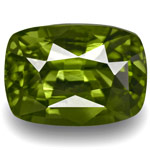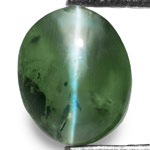Alexandrite, named after young Tsar Alexander in the 1830s, displays a color change from emerald green to red by artificial light. Considered a gem of joy and good omen.
 Rare and precious, alexandrite is one of the birthstones of June and the gemstones of the astrology sign Gemini. It is prized as a good luck charm and said to bring joy and self-confidence to a wearer. Presented to Russian Tsar Alexander II on his coming of age, alexandrite or “tsarstone” is linked in history with the final days of the Russian monarchy.
Rare and precious, alexandrite is one of the birthstones of June and the gemstones of the astrology sign Gemini. It is prized as a good luck charm and said to bring joy and self-confidence to a wearer. Presented to Russian Tsar Alexander II on his coming of age, alexandrite or “tsarstone” is linked in history with the final days of the Russian monarchy.
Multicolored Alexandrite
Alexandrite is one form of the mineral chrysoberyl, which has three varieties: yellow chrysoberyl or chrysolite, cat’s eye or cymophane, and alexandrite. Alexandrite is usually green or gold, but it may occur in shades from orange to yellow and, occasionally, blue.

The most common alexandrite, and the color that was first discovered in the 1830s, is emerald green in daylight but color changes to purplish or blood-red by artificial light at night. Yellow alexandrite tends to turn raspberry red or pink by artificial light. This color change has engendered the word “alexandritic,” which is applied to other stones that change colors (sapphire, garnet, and spinel), as well.
Alexandrite is very rare, making it one of the most expensive gemstones today – particularly those with rich colors and strong color changes. It has a hardness of 8.5 on the Mohs scale. Alexandrite is sometimes called “tsarstone” for its historic connection with the ruling Tsars of Russia.
Alexandrite in History
Some historians claim that the first alexandrite was discovered on the coming of age of the Russian Tsar, Alexander II, on his sixteenth birthday on April 17, 1834. But earlier records show that a vein of “emeralds” was found at the same location in the Ural mountains several years earlier, in 1830 or 1831.
The gem was named “alexandrite” after the young Tsar and became immediately valuable in tsarist Russia for its clarity, hardness, and it’s colors of red and green – the colors of Imperial Russia.
Magical Significance and Powers of Alexandrite
Like most gemstones, alexandrite has been attributed with a long list of healing and magical powers. Alexandrite is said to:
- bring good luck
- improve self-esteem
- bring joy
- heal the nervous system, spleen, and pancreas
- inspire creativity and strengthen intuition
Alexandrite Gemstone in Jewelry
Alexandrite makes beautiful jewelry, and rings, bracelets, pendants, and earrings are designed to set off the colors of the gem and to display its color-changing properties. Alexandrite is considered the gemstone of the 55th wedding anniversary, when it may be given as a gift, and is one of the birthstones for the month of June alongside pearl and moonstone.
Alexandrite has been found in Russia, Brazil, India, Madagascar, Myanmar, Tanzania, Australia, the United States, Sri Lanka, and Zimbabwe.
Reference
- Alexandrite Tsarstone Collectors Guide, “Alexandrite Encyclopedia,” Alexandrite.net, 2009.
- All That Gifts, “Gemstones: Alexandrite,” All-That-Gifts.com, 2005.
- International Colored Gemstone Association, “Alexandrite,” Gemstone.org, 2009.
